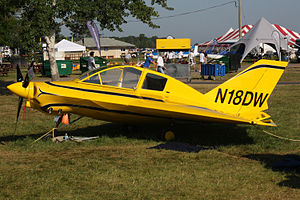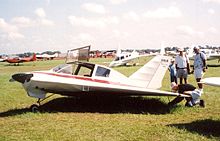- Dyke Delta
-
JD-2 Delta EAA AirVenture 2008 Role Utility aircraft Manufacturer Homebuilt Designer John and Jennie Dyke First flight July 1966 Number built 50 Sun 'n Fun 2003
The Dyke JD-2 Delta is a utility aircraft designed in the United States in the 1960s and marketed for homebuilding. It is a monoplane with retractable tricycle undercarriage and seating for four. The wings can be folded for towing or storage and hinge upwards to lie flat above the fuselage, one atop the other. Construction is of 4130 steel tube framework with fiberglass and fabric skins. In its standard configuration, the aircraft is a true double-delta with no horizontal stabilizer, a small T-tail, for trimming higher-power engines is an option. Since the mid-1960s, designer John Dyke has sold the aircraft plans to homebuilders. No kits were ever marketed. Over fifty examples have been completed.[1]
Development
The Dyke Delta is an example of an experimental amateur-built aircraft.
Dyke is reputed[by whom?] to have said that the Delta "flies like other planes should but don't", probably referring to the benign (virtually non-existent) stalling characteristics at low all-up weights.
Designer John Dyke said his inspiration for the aircraft came from Alexander Lippisch's delta designs, specifically the LP-6 glider and later the Convair F-102 Delta Dagger. The double delta layout of the Saab 35 Draken was incorporated into the design. A lifting body fuselage was incorporated after tests.[2]
For research into the proposed layout, Dyke built models mounted on the front of his car and flew radio-controlled models to determine aerodynamic qualities. When the original Dyke JD-1 Delta was destroyed in a garage fire, after 145 hours of flight-testing, his wife persuaded Dyke to build an improved version as the Dyke JD-2 Delta.
The Dyke Delta JD-2 is among the most successful delta-wing civilian aircraft ever designed, flying for the first time on July 18, 1966,[3][citation needed] with the prototype flying over 2,000 flight hours in 40 years.
Design
The fuselage, wing spars and tail assembly are made from 4130 Chrome-moly steel tubing. The wing ribs are made from 0.019" steel channel along with 0.015" stainless steel formed from flat stock into a double-beaded "U" channel. The rib truss work is nickle-silver brazed together into ribs and onto the spars. The spar and ribs are a "Pratt Truss" design. The wing and fuselage skins are made of laminated fiberglas: 4-layers of 7½ ounce cloth and polyester resin. The skins end up around 0.065" to 0.070" thick and are held onto the ribs with 1/8" countersunk rivets.[citation needed]
The control surfaces and underside of the fuselage (center section) are covered with conventional aircraft (e.g. Dacron) fabric.
The upper fuselage/center section is the turtleback. It is formed as a fiberglass unit from hardboard ("Masonite") molds. Several variations have been created. The fuel tank is located in the turtledeck right behind the passenger compartment which violated FAR Part 23 standards for separating fuel tanks from passengers. Building fiberglass fuel tanks has caused problems because fuel additives or contaminants will degrade and dissolve the resin in the composite matrix.
The engine cowling is also made of fiberglass, laid in layers around a foam core. Once shaped, it is removed, the core stripped out and then other layers of fiberglass (stiffeners) are laminated in to strengthen the cowling.
The retractable landing gear (via levers and bellcranks) is made from 6150 steel, chosen for its strength and torsional properties. The gear assemblies are formed in the annealed condition to permit welding. Once assembled, it is heat treated. The retractable gear adds another 16 - 20 mph to the cruise speed along with decreased sink rate and a better rate of climb. The retraction sequence is very quick, lasting less than 5 seconds.
Construction time varies widely with builder commitment, skill sets, tools, access to metal forming equipment, etc. Some Deltas have been built under 2,000 man hours and under two years but six or eight years is more typical.
- Single engine in forward tractor position. Better than a rear engine (as in Long-EZ's) in a crash.
- No horizontal tail feature. No ability to increase lift factor with flaps and limited lift increase with angle of attack.
- Single full-time pilot because the controls are not duplicated to a side or rear seats. Not suitable for training. In an emergency others would have difficulty taking over pilot functions.
- Steel tube frame which is good for crash protection but the crash energy in the high speed emergency landings could easier overwhelm the structure. Strongly consider a BRS (Ballistic Recovery Chute).
- 3-place (although the 4th small passenger could fit in the middle of the rear bench but because of the other factors this is a higher risk aircraft for passengers).
- higher cruise speed (~170 MPH) using a 180 HP Lycoming (at Gross Wt. (<?>) than most conventional aircraft of the same weight but slower than high performance aircraft of the same weight.
- minimal CG changes due to the fuel and passenger load being centered on the main spar which is close behind the empty CG location.
- low aspect ratio: the wing area divided by wing span (see span formula) this gives low drag but poor glide performance.
- option to build folding wings/removable for storage in a single car garage or highway transport
The delta configuration offers a relatively high cruise speed compared to conventional aircraft of the same weight and power and a relatively high stall speed of 70 to 75 Mph. Approach speeds range from 110 to 100 mph with a flare at 70 mph.[4]
Operational history
Including the prototype, under a dozen are in a known flying condition today though nearly that many are currently under construction. One flying Dyke JD-2 Delta is N18DW (s/n 1093), which was constructed in the late 1960s. The bright yellow aircraft was a frequent visitor to EAA fly-ins throughout the 1970s, until it suffered an engine failure which resulted in a severe landing accident en route to Oshkosh, Wisconsin in 1979. The pilot attempted to land the aircraft on a roadway, but the gear caught the road edge and the aircraft was propelled into a farmer's henhouse, resulting in no injuries to the pilot and passenger, but the death of two hens. The remains of N18DW remained in to owner's garage until 2006 when work commenced on restoring the aircraft to flying condition. A larger and more powerful engine was installed, and the cabin was shortened by 5 inches, while the cowling was lengthened by 5 inches to balance the aircraft. Dyke traveled to Florida several times to view the restoration and modifications. The restored aircraft flew for the first time in October 2007. It resides inside the owner's home on Key Largo, Florida and has been restored to its former yellow paint scheme.[4]
Several machines are under construction in the US, Canada and Australia. Within America, builders can be found in California, North Carolina, New Hampshire, Wisconsin, Texas, Washington, Oklahoma, Minnesota and other states.[citation needed]
There has been only about one example built per year since the prototype. Contrast this with hundreds of other designs. The tapered wing does give some structural advantages in strength and stiffness that is missing from other aircraft designs. Unfortunately the best features of various designs are not combined in Experimental homebuilt designs.
The Dyke Delta was involved in NASA-funded flight-testing[when?]. Kelly Aerospace towed the Delta behind another aircraft to obtain flight towing and engine-off (glider) controllability data for use on future space-travel designs. The Dyke Delta flew quite well in tow and in a glide. Over the years, the JD-2 structure was evaluated by the University of Utah and the Wright Patterson Air Force Base (Ohio) Structural Lab.[citation needed]
Variants
Preceded by the JD-1 Dyke Delta - a slightly smaller version of the JD-2 that was lost on June 4, 1964[3] in an accidental garage fire after about three years of service. Portions of the JD-1 were used in constructing the JD-2.
The Delta Stingray was a one-off development effort by Dyke utilizing wood construction for the single-place airplane. It was flown for nearly 30 years before being retired to a museum.
Specifications Dyke Delta
General characteristics
- Crew: One pilot
- Capacity: 3: 2 passengers comfortably with a small third passenger in the center bench seat position
- Length: 19 ft 0 in (5.79 m)
- Wingspan: 22 ft 3 in (6.87 m)
- Height: 5 ft 6 in (1.68 m)
- Wing area: 173 ft2 (16.0 m2)
- Empty weight: 1,060 lb (481 kg)
- Gross weight: 1,980 lb (884 kg)
- Powerplant: 1 × Avco Lycoming O-360, 180 hp (134 kW)
Performance
- Maximum speed: 200 mph (322 km/h)
- Cruise speed: 170 mph ( km/h)
- Range: 870 miles (1,400 km)
- Service ceiling: 14,500 ft (4,420 m)
See also
- Aircraft of comparable role, configuration and era
- Baker MB-1 Delta Kitten
- Facetmobile
Notes
References
- Sargent, Sparky Barnes (December 2008). "A Dyke Delta Reborn". EAA Sport Aviation 57 (12): 26–32.
- Taylor, Michael J. H. (1989). Jane's Encyclopedia of Aviation. London: Studio Editions. pp. 347. ISBN 0710607105.
- Jane's All the World's Aircraft 1987-88. London: Jane's Yearbooks. pp. 659. ISBN 0710608500.
- Dyke, John W. (May 1968). "Dyke Delta JD-2". EAA Sport Aviation 16 (5): 4–7.
External links
Aircraft designed by John and Jennie Dyke JD-1 • JD-2
Lists relating to aviation General Aircraft (manufacturers) · Aircraft engines (manufacturers) · Airlines (defunct) · Airports · Civil authorities · Museums · Registration prefixes · Rotorcraft (manufacturers) · TimelineMilitary Accidents/incidents Records Categories:- United States civil utility aircraft 1960–1969
- Homebuilt aircraft
- Delta-wing aircraft
- Single-engine aircraft
- Propeller aircraft
- Fairborn, Ohio
Wikimedia Foundation. 2010.


